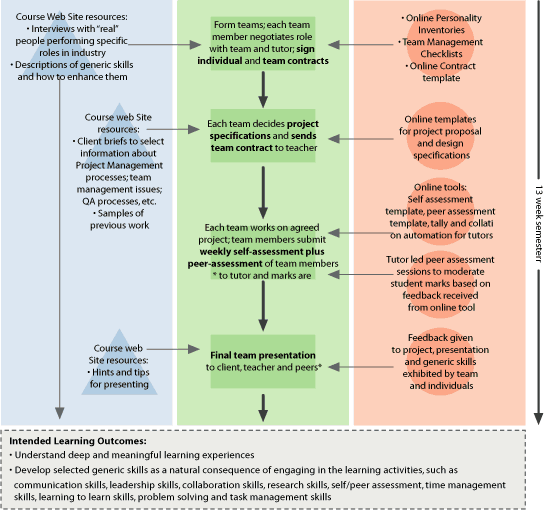 |
 |
| |
 |
 |
 |
 |
 |
 |
 |
| Generic
Skills Development
|
 |
 |
 |
 |
 |
 |
 |
 |
 |
 |
 |
 |
top

| |
The learning design comprises four main activity stages,
with a a range of resources and support mechanisms. The Learning
Design Sequence is illustrated as follows.


Download PDF Version
|
top

| |
WHAT THE STUDENTS DO
As illustrated in the Learning Design Sequence, the sequence
of activities students are required to follow are:
- Decide on a team role (project manager, graphic design,
programmer, instructional designer or content developer).
- Negotiate within a team of four students the exact responsibilities
of this role, which include major deliverables for each
assignment, the approximate hours of work, and an estimate
of the quality of work (grade expectation).
- Once teams are formed and contracts are signed, the team
then decides on a suitable project the team can develop
that will help enhance their employment opportunities. Completed
projects are hosted on the university's server as part of
an electronic portfolio.
- Students then use all the resources (both face-to-face
& online) to develop documentation (project proposal,
costing, design specification, legal contracts and evaluation
reports) and products for clients.
- As all the teams are developing these projects, individual
students complete weekly self/peer assessment journals.
Based on these entries, the online application prepares
confidential reports for tutors.
- Tutors then use these reports to conduct "Tutor Led
Peer Assessment" sessions, and moderate marks of individual
students within each team according to their contributions
and quality of work.
SIGNIFICANCE OF ORDER
Students must firstly take ownership of and commit to their
team role within a team of four students before commencing
the project. It is important for students in this unit (final
year multimedia students) to consider what job placements
they will be focusing on when they finish the course. This
unit gives them the opportunity to experience these skills
in an authentic setting with a variety of supports.
After each student has committed to a team role (through
the contract system) they them engage with activities that
promote project management skills, as well as generic skills
needed in the industry.
CRITICAL ACTIVITIES
The critical activities that underpin the design include:
- Deciding on a team role, and committing to it through
a contract.
- Selecting a team of 4 students and selecting a suitable
project that will help promote their skills to the industry.
- Using the self/peer assessment tools to help "keep
the team honest".
- Selecting appropriate resources needed to complete the
project.
|
top

| |
ACCESSIBLE RESOURCES
- A text book written specifically for this course.
- Two Readers with contemporary information on multimedia
project management.
- Procedures and templates appropriate to each topic covered
each week.
- Hits and tips for each topic.
- URLs and other resources for each weekly topic.
- Documentation and projects developed by previous students
(online).
- Generic skill definitions, information and strategies
for improvement.
RESOURCES IN CONTEXT
The resources provide the basic domain-specific knowledge
required for this unit. Students decide which of these resources
are most appropriate for their needs and roles i.e. students
are required to make decisions about which resources are most
relevant for their tasks and skills.
VARYING THE RESOURCE SET
The self-regulated nature of the environment requires a large
resource base, so that students can freely make choices about
which resources are most appropriate for their skills. It
would be difficult to remove any of the above resources.
|
top

| |
SUPPORTS SUPPLIED
The supports provided to the student includes:
- Samples of multimedia job adverts and specifications to
help students determine required skills for their team role.
- Online contract template. Requires students to determine
– project topic, client name, team role, estimated
time, major deliverables and quality (grade).
- Online procedures and templates to help with content specific
tasks such as project proposal, design specifications, legal
contract etc.
- Online application for self and peer assessment. Enables
students to confidentially report on their peers. This allows
tutors to quickly gauge how students are operating within
their teams.
- Tutor led peer assessment sessions. Allows tutors to discuss
and negotiate how marks should be re-distributed within
the team on the basis of deliverables and quality of work.
- Feedback obtained from clients, other teams and tutor
on the quality of their products, documentation and presentation
skills.
SIGNIFICANCE OF SUPPORT STRATEGIES
The supports provide authentic tools that encourage students
to engage with the content, and motivate them to complete
the given exercises.
SUPPORT STRATEGY ADAPTATION
Almost all of the supports are necessary to help students
engage with the content. The contract, self/peer assessment,
tutor-led peer assessment and feedback all provide authentic
learning experiences.
|
top
|
 |
 |
 |
 |
 |
 |
 |
 |
 |
|
